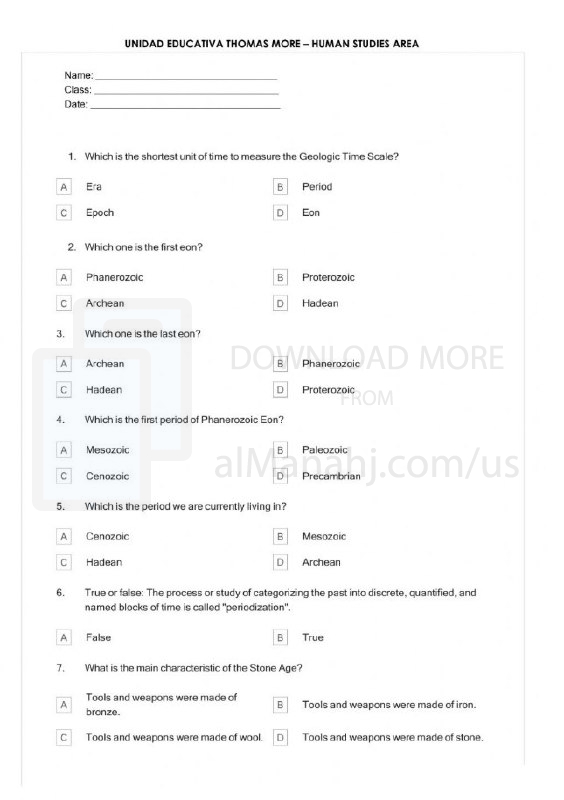| You are here: Almanahj Website ⇒ American curriculum ⇒ 5th Grade ⇒ Geology ⇒ Term 1 | ||
|---|---|---|
Worksheet about Human Studies Recovery Activity Geologic and Prehistory | ||
|---|---|---|
| Subject: Geology | ||
| 5th Grade | ||
| Term 1 | ||
| Year: 2023/2024 | ||
| Size: 260.1KB | ||
| Number of clicks: 72 | ||
| Publish date:November 21, 2023 | ||
| Added by: Eman | ||
| Last download date: 2024-08-18 19:00:53 | ||
| Updated by: Eman9966 on 2023-11-21 17:16:23 | By: theodor Genesis Villón Cubi | |
| File info: Sure, here is a Human Studies Recovery Activity that focuses on geology and prehistory: Activity Title: Unearthing the Past: A Geological and Prehistoric Exploration Grade Level: 5-8 Learning Objectives: Students will be able to: Define and explain key geological concepts, such as rock formations, fossils, and geologic time. Identify and classify different types of rocks based on their properties. Understand the connection between geological processes and the formation of prehistoric landscapes. Analyze fossil evidence to reconstruct prehistoric environments and identify extinct organisms. Appreciate the importance of preserving geological and archaeological sites for future generations. Materials: Variety of rocks (e.g., igneous, sedimentary, metamorphic) Magnifying glasses or hand lenses Fossil replicas or images of fossils Geological maps or diagrams Chart paper or drawing materials Writing utensils Procedure: Part 1: Rock Exploration Introduce students to the concept of rocks as the building blocks of the Earth's crust. Explain that rocks are formed through different geological processes over millions of years. Provide students with a variety of rock samples and ask them to observe their properties, such as color, texture, hardness, and weight. Encourage them to use magnifying glasses or hand lenses to examine the rocks closely. Introduce the concept of rock classification and explain the three main types of rocks: igneous, sedimentary, and metamorphic. Guide students in classifying the rock samples based on their properties and formation processes. Discuss the connection between rock formations and geological processes. Explain how different types of rocks can provide clues about past geological events, such as volcanic eruptions, erosion, and plate tectonics. Part 2: Fossil Investigation Introduce students to the concept of fossils as the preserved remains or traces of prehistoric organisms. Explain that fossils provide direct evidence of life in the past. Display fossil replicas or images of fossils and ask students to observe their features, such as shape, size, and patterns. Encourage them to infer what type of organism the fossil may have represented. Discuss the process of fossilization and explain how fossils are formed under specific conditions. Explain how fossils are used to reconstruct prehistoric environments and identify extinct organisms. Guide students in creating a fossil chart or drawing, categorizing different types of fossils and their corresponding organisms. Encourage them to describe the characteristics of each fossil and its significance as a record of past life. Part 3: Prehistoric Landscape Reconstruction Provide students with geological maps or diagrams of prehistoric landscapes. Ask them to analyze the map and identify different geological features, such as rock formations, rivers, and mountains. Discuss the connection between geological processes and the formation of prehistoric landscapes. Explain how geological forces, such as erosion, deposition, and plate tectonics, have shaped the Earth's surface over time. Guide students in reconstructing the prehistoric environment based on the geological features they have identified. Encourage them to consider factors such as climate, vegetation, and possible prehistoric inhabitants. Discuss the importance of preserving geological and archaeological sites for future generations. Explain how these sites provide valuable insights into Earth's history and the evolution of life. Assessment: Observe students' participation in discussions and activities. Evaluate students' rock classification and fossil identification skills. Assess students' ability to reconstruct prehistoric environments and explain geological processes. Review students' written work or charts related to fossils and prehistoric landscapes. Extension Activities: Visit a local museum or natural history center to observe rock and fossil collections. Watch documentaries or read books about geology, paleontology, and prehistoric life. | ||
| Downloading link Worksheet about Human Studies Recovery Activity Geologic and Prehistory |
|---|
|
1700586592.pdf
The file is being prepared for download
|
| File images |
|---|
 |